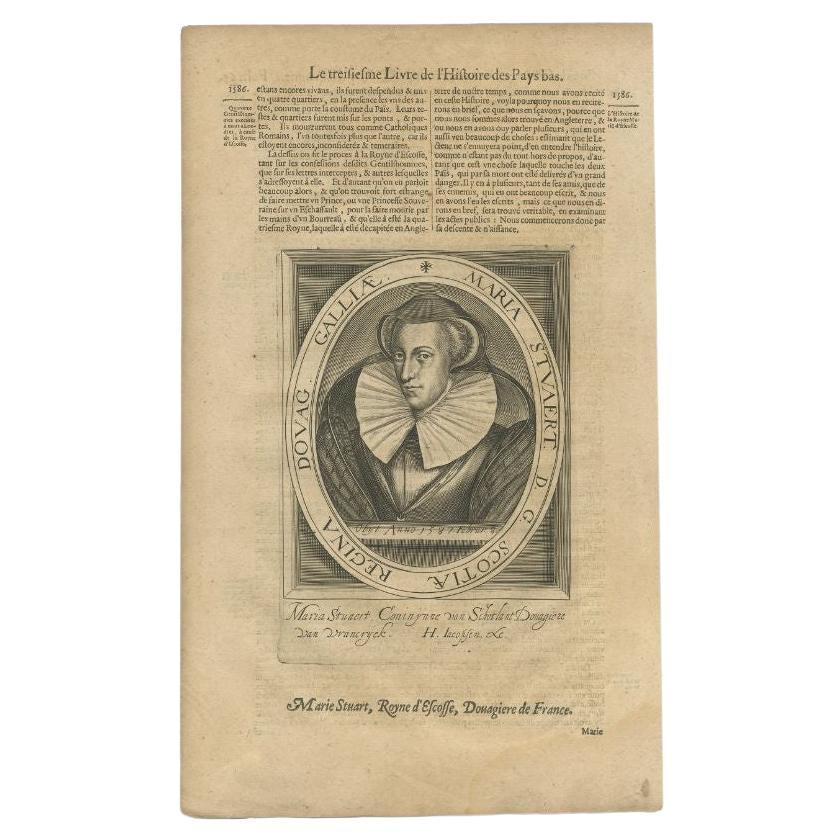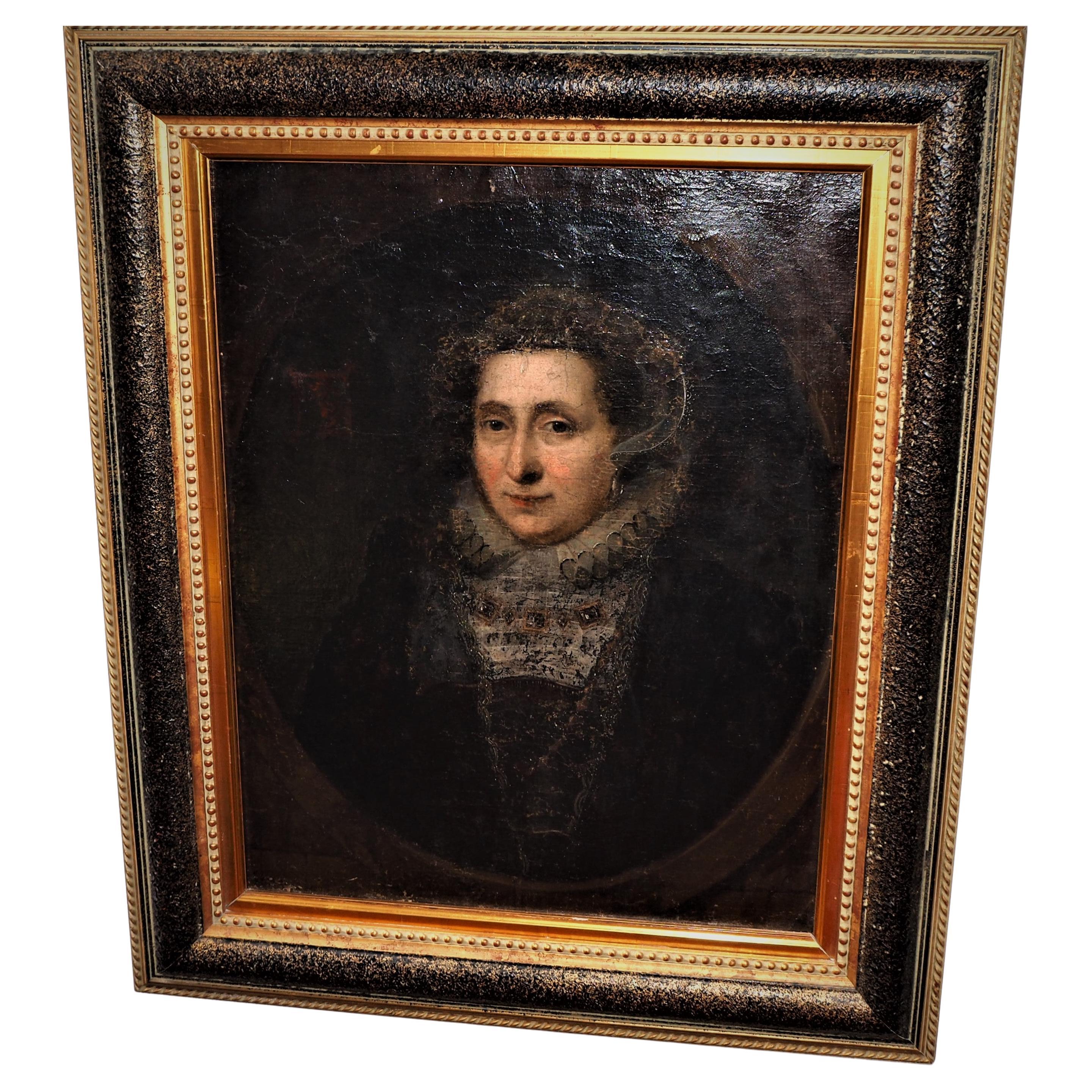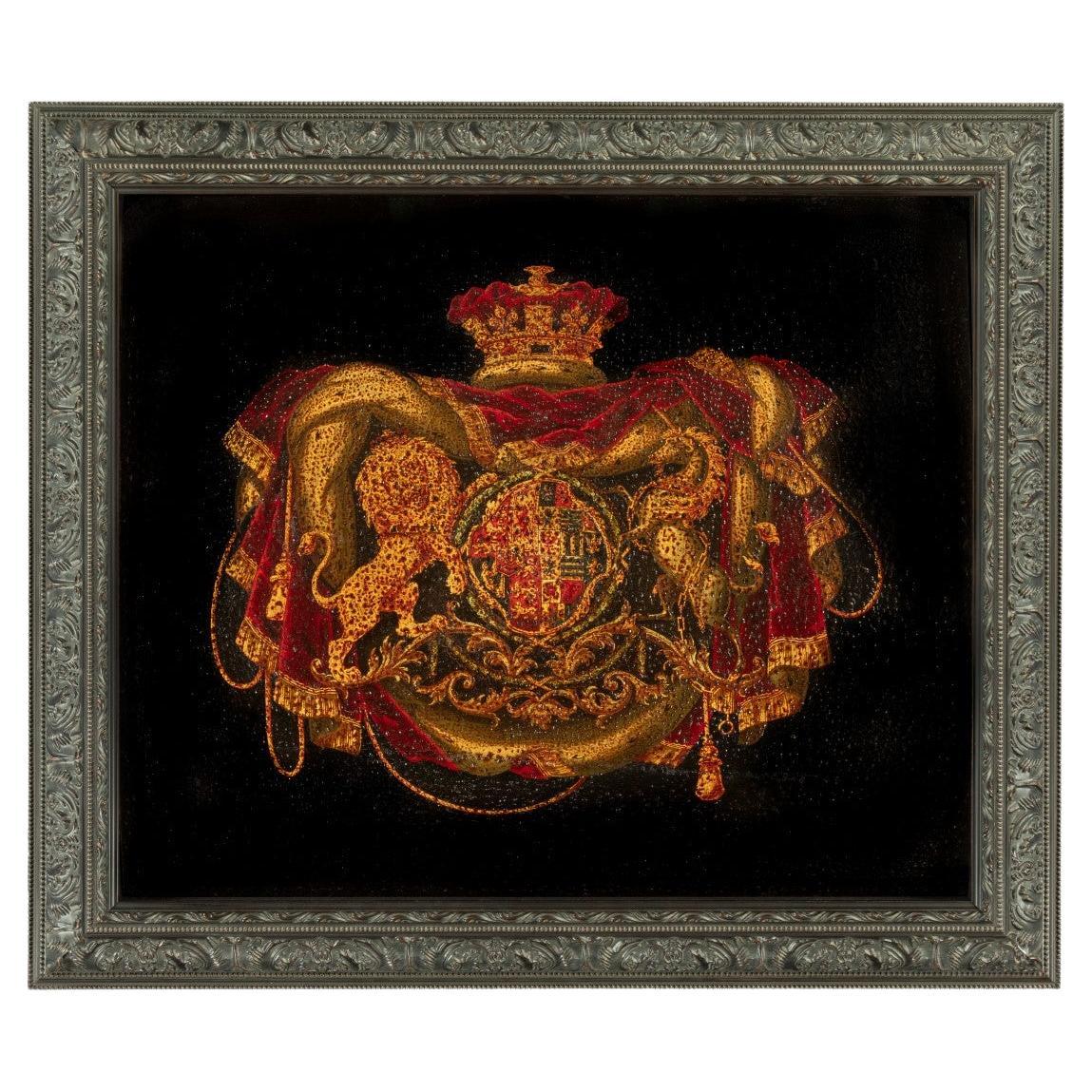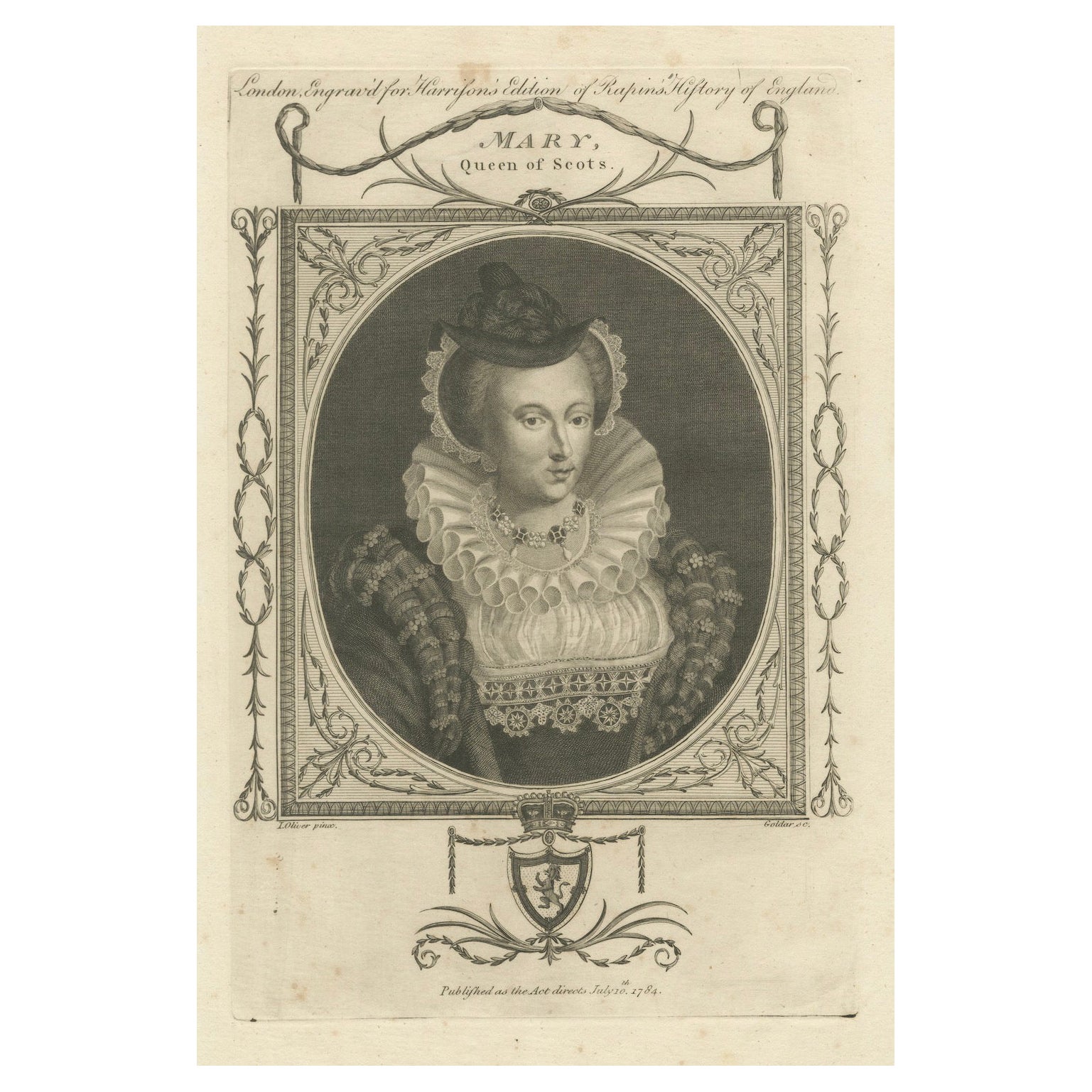Items Similar to Large Wool and Glass Beads Needlework Panel of Mary Queen of Scots
Want more images or videos?
Request additional images or videos from the seller
1 of 9
Large Wool and Glass Beads Needlework Panel of Mary Queen of Scots
About the Item
Large wool and glass beads needlework panel of Mary Queen of Scots
Scottish, circa 1870
Panel: Height 107cm, width 150cm, depth 2cm
Frame: Height 155cm, width 187cm, depth 20cm
Handmade by a group of Scottish sisters from the Stark family around 1870, this needlework picture panel portrays an important scene from British history.
Mary Queen of Scots is seen weeping over the dying George Douglas of Lochleven at the Battle of Langside in which she was defeated. This event was significant because it let to Mary’s imprisonment in England under the command of Elizabeth I in 1568.
The piece is crafted in polychrome wool with detailing such as jewellery or shadows are highlighted in shining glass beads.
Charles Landseer’s painting acted as an inspiration for the piece. Landseer was a renowned English artist and was known for the depiction of historical scenes. Embroiderers looked for inspiration in his paintings, with some of the needlework pieces inspired by Landseer's paintings being displayed at the Great Exhibition in 1851.
The needlework panel is framed in an exquisitely carved giltwood frame. A painted plaque with an inscription: ‘QUEEN MARY / Weeping Over the Dying / DOUGLASS / at the Battle of Langside / 1568' is visible in the lower centre of the frame.
Beautifully crafted using an unusual combination of materials, this piece would make a stunning addition to the appropriate interior space.
- Dimensions:Height: 61.03 in (155 cm)Width: 73.63 in (187 cm)Depth: 7.09 in (18 cm)
- Style:Victorian (Of the Period)
- Materials and Techniques:
- Place of Origin:
- Period:
- Date of Manufacture:circa 1870
- Condition:Wear consistent with age and use.
- Seller Location:London, GB
- Reference Number:
About the Seller
5.0
Recognized Seller
These prestigious sellers are industry leaders and represent the highest echelon for item quality and design.
Established in 1975
1stDibs seller since 2012
362 sales on 1stDibs
Typical response time: 5 hours
Associations
The British Antique Dealers' AssociationInternational Confederation of Art and Antique Dealers' Associations
- ShippingRetrieving quote...Ships From: London, United Kingdom
- Return PolicyA return for this item may be initiated within 14 days of delivery.
More From This SellerView All
- Pair of Very Fine, Large Italian Pietra Dura Marquetry PanelsLocated in London, GBA pair of very fine, large Italian Pietra Dura marquetry panels Italian, 19th century Measures: Panels: height 64cm, width 53cm, depth 2cm Frames: height 88cm, width 77cm, depth 6cm Comprising black marble panels of oval form, set with semi precious stones, these exceptional panels are inlaid to depict a bouquet of flowers in antique vases...Category
Antique 19th Century Italian Grand Tour Decorative Art
MaterialsMarble
- Large Victorian Ceramic Tile Panel by John Moyr Smith for MintonsBy John Moyr Smith, MintonLocated in London, GBLarge Victorian ceramic tile panel by John Moyr Smith for Mintons English, circa 1878 Panel: height 83cm, width 62cm, depth 0.5cm Frame: height 89cm, wid...Category
Antique Late 19th Century English High Victorian Ceramics
MaterialsCeramic, Wood
- Large Marble Figurative Relief Panel by PegramBy Henry PegramLocated in London, GBLarge marble figurative relief panel by Pegram English, Early 20th Century Plaque: Height 102cm, width 70cm, depth 9cm Frame: Height 109cm, width 89cm, depth 2cm This bright white...Category
Early 20th Century English Art Deco Decorative Art
MaterialsMarble, Iron
- 19th Century KPM Porcelain Plaque of the Queen of PrussiaBy KPM PorcelainLocated in London, GBThis beautiful antique porcelain plaque exhibits the fine quality of craftsmanship and artistry that the prestigious Berlin porcelain manufactory, KPM, is renowned for. The plaque is delicately painted with the full-length portrait of Duchess Louise of Mecklenburg-Strelitz (1776-1810), Queen of Prussia and wife of King William III (1770-1840). Louise was a popular Queen and was respected for her successful negotiations with Napoleon, before he became Emperor of France. In this plaque, she is depicted descending the steps of the Charlottenburg Palace, Berlin, which was the seat of the Prussian monarchy. She wears a simple robe a l'anglaise, which was fashionable at the time, and looks directly at the viewer in a symbol of power and majesty. The plaque is signed to the lower right by the artist 'Emile Eckhart', who worked for KPM. It is painted after a famous work by celebrated German artist Gustav Karl Ludwig Richter...Category
Antique Late 19th Century German Decorative Art
MaterialsPorcelain
- Large Pair of Circular, Patinated Bronze Relief Plaques of Night and DayLocated in London, GBA pair of patinated bronze antique plaques of Night and Day French, Late 19th Century 80cm in diameter, 5cm in depth Modelled after Bertel Thorvaldsen's iconic 'Night and Day' relie...Category
Antique Late 19th Century French Neoclassical Decorative Art
MaterialsBronze
- Antique Italian Figurative Pietra Dure PanelLocated in London, GBAntique Italian figurative pietra dure panel Italian, 19th century Measures: Height 18cm, width 14cm, depth 1cm This beautiful pietra dure panel depicts in the Renaissance style...Category
Antique 19th Century Italian Renaissance Decorative Art
MaterialsMarble
You May Also Like
- Antique Portrait of Mary Stuart, Queen of Scots, 1618Located in Langweer, NLAntique portrait titled 'Maria Stuaert (..)'. Old portrait of Mary Stuart, Queen of Scots. This print originates from 'L'histoire des Pays-Bas d'Emanuel de...Category
Antique 17th Century Prints
MaterialsPaper
- Attractive Late 19th Century Needlework PanelLocated in Lymington, HampshireDepicts a fanciful scene of children returning form the harvest in an idyllic rural landscape. The leaders are playing pipes with a dog frisking at their feet, while the remaining pa...Category
Antique 1890s French Tapestries
MaterialsFabric
- Mary Queen of Scots period painting 16th.CenturyLocated in Perth, GBThis painting very much of the period of George Jamieson although with a contintal flavour It is worth considering this artist , He was born in Aberdeen, where his father, Andrew Jamesone, was a stonemason. Jamesone attended the grammar school near his home on Schoolhill and is thought to have gone on to further education at Marischal College.[2] Legend has it that Jamesone once studied under Rubens in Antwerp with Anthony van Dyck.[3] This is, however, yet to be proven as his name does not appear to be noted on the Guild registers of the town.[4] Since Rubens was exempt from registering pupils, the absence of Jamesone's name does not mean that the painter definitely did not study there. Mary Erskine Jamesone certainly did complete an apprenticeship under the supervision of his uncle, John Anderson, who was a popular decorative painter in Edinburgh at the beginning of the seventeenth century.[5] Jamesone finished this training in 1618. He is not recorded as being in Aberdeen again until 1620. If the Scotsman had gone to Antwerp, it would have had to have been between the years of 1618 to 1620. Career Whilst in Aberdeen, Jamesone made a name for himself painting portraits of local academics and scholars from the city's two feuding colleges: King's and Marischal. In 1633, when Charles I made his grand royal visit to Edinburgh, Jamesone rose from local to national fame. For this occasion the painter was asked to decorate a highly elaborate triumphal arch with the portraits of all the past kings of Scotland.[6] He was also given the honour of painting the portrait of Charles himself. It has been said that the king was so pleased with the result that he gave Jamesone a ring off his own finger as a reward.[7] After hearing of the King's approval, many of the Scottish gentry desired to be painted by the now highly reputable George Jamesone.[3] One of his finest examples is that of Mary Erskine which is on display at the National Gallery of Scotland. Jamesone had homes and studios in Aberdeen (on Schoolhill opposite St. Nicholas Kirk) and in Edinburgh (on the Royal Mile right next door to John Knox House). Having two bases allowed him to meet the demands of hundreds of patrons from the north to the south of the country. Jamesone died in Edinburgh in 1644 and was buried in Greyfriars Kirkyard in the centre of the city. The grave is largely illegible but lies on the east wall of the original churchyard.[8] Legacy Lady Janet Stewart Jamesone's pupil, John Michael Wright...Category
Antique 16th Century Scottish Elizabethan Paintings
MaterialsCanvas
- Queen Adelaide’s Coach PanelsLocated in Lymington, HampshireThese two wood panels are of rectangular form, one with rounded corners. Each is painted with a large Royal coat of arms flanked by a lion and a unicorn surmounted by a queen’s crown and red velvet mantling trimmed...Category
Antique 1840s English Historical Memorabilia
MaterialsWood
- 1784 Engraved Elegance of Mary, Queen of Scots - Tragic MonarchLocated in Langweer, NLThis is an authentic engraved portrait of Mary, Queen of Scots. Mary was one of the most fascinating and tragic figures in Scottish and English history. She became queen consort in...Category
Antique 1780s Prints
MaterialsPaper
- Old Handcolored Print of Stuart Mary, Queen of Scots, 1805Located in Langweer, NLAntique costume print titled 'Maria Stuart - Marie Reine d'Ecosse en 1570'. This print depicts Mary, Queen of Scots. She reigned over Scotland from ...Category
Antique Early 1800s Prints
MaterialsPaper
Recently Viewed
View AllMore Ways To Browse
Ruth Gowell
William Russell Birch
Zieta Skateboard
Amado Maurillo Pena
Antique Tin Carousel
Arthur Shilstone Artist
Aston Martin Db5 Vintage
Aston Martin Vintage Db5
August Stephan Sedlacek
Benjamin Maund
Carta Blanca
Clapera Maya
Delft Bird In A Cage
Giorgio Tonti
Harold Beament
J Roybal
Jimi Hendrix Plastic Record
Lionello Balestrieri





